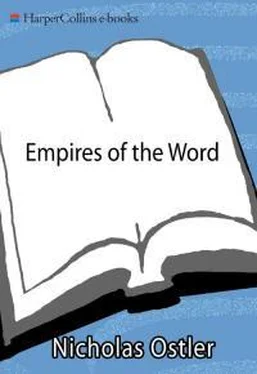I should reassure linguists reading this that I am consciously ignoring the structure latent in the vast amount of vocabulary borrowed from, or constructed out of, Latin, French and Greek.
To my knowledge, only the Japanese ’kanbun’ tradition of marking up classical Chinese text to be read out just as if it were in Japanese has had the chutzpah to dispense with that basic convention.
It, and the island of Croatoan, to which it famously but mysteriously decamped, were actually on the coast of modern North Carolina. The few survivors, merging with local Algonquian speakers, were to drop their English in the seventeenth century. But English did survive in the follow-up colony at Jamestown, whose capital was later moved to Williamsburg.
It is interesting to note that one major motive for Rome and Russia, the drive to secure borders by conquering neighbours, was largely absent.
The term is an anachronism, but the concept is not. Hakluyt organises the document, Discourse of Western Planting , with all the striking content on the second page, chapter headings that tell it all: A particuler discourse concerninge the greate necessitie and manifolde comodyties that are like to growe to this Realme of Englande by the Westerne discoveries lately attempted, Written In the yere 1584 by Richarde Hackluyt of Oxforde at the requeste and direction of the righte worshipfull Mr. Walter Raghly [Ralegh] nowe Knight, before the comynge home of his Twoo Barkes: and is devided into xxi chapiters, the Titles whereof followe in the nexte leafe.
Chesapeake Bay, the site of the Virginia colony, had in fact been the northern boundary of Spanish Jesuit activities in ‘la Flórida’. From 1565 this had included small settlements in the modern Georgia, Carolinas and Virginia, but the whole area was abandoned in 1572 after eight missionaries were killed at Chesapeake.
Pocahontas was in many ways an exceptional woman. Seven years earlier, when still a girl, she had intervened with her father to save the life of another English pioneer, Captain John Smith, who went on to become the Jamestown colony’s first governor. When John Rolfe won her hand, she had still been confined against her will on an English ship on the Potomac river. She later became an early convert to Protestant Christianity.
The French had, as it happened, already studied the Algonquin language, when exploring the Ottawa river valley in 1541.
Swedish presence on the Atlantic seaboard was of fairly short duration (1638-55); their settlement in Delaware had been summarily evicted by the Dutch.
In 1867, Alaska too was acquired, by purchase from Russia.
This has been transmuted into the legend that at one point German was almost to be declared the official language of the USA.
German remained the second-largest language of immigrants (at 25 per cent) during the nineteenth and twentieth centuries. There was a surge of German-speaking immigrants in the early nineteenth century, and a tendency early on for them to congregate in Pennsylvania. It peaked in the 1870s, when 600,000, among a state population of 4 million, are said to have had German (’Pennsylvania Dutch’) as their everyday language, with another 150,000 outside the state. The popular use of German in public was very severely damaged by the First World War. It survives today only in small sectarian communities such as the Mennonites and Amish (Adams 1990: ch. 7).
This is made up of 14 per cent from the UK, 13 per cent from Ireland, 12 per cent from Canada, 4 per cent from the Philippines and 1 per cent from Jamaica. After German with 25 per cent, the next languages are Russian (10 per cent), Hungarian (4 per cent) and Chinese (3 per cent) (US Dept of Justice, 1998 Statistical Yearbook, quoted in Wright 2000: 291).
New York’s ‘Bowery’ perpetuates the name of the farm of Pieter Stuyvesant, the last Dutch governor.
Over 1.2 million Britons for 55,000 French.
Arizona, California, Colorado, Florida, Nevada, New Mexico, Texas, Utah, Wyoming.
By interesting coincidence, the cities that grew up around them, which went on to become the first centres of government for British India, have all been renamed in the 1990s: as Chennai, Mumbai and Kolkata.
Gujarati vāniyān , ‘merchants’, Hindi dubhā·iya , ‘bilingual’ (Yule and Burnell 1986 [1903], s.vv.).
The Mughals had brought Persian to India in the sixteenth century as their language of culture, although their ordinary sipāhi (’sepoy’) spoke Turkic. There is something strangely analogous to the Norman conquest of England here, with Persian in the role of French, and Delhi’s vernacular, developing into ’Urdū’ under Persian influence, in the role of English. In this sense Urdu, literally ‘language of the camp’, was the distinctive linguistic creation of the Mughals in India. And it was this, not English, which was to become the major language of the British Indian Army. (See Chapter 5, ‘Sanskrit no longer alone’, p. 222.)
Arabic ‘educator, composer’ (Yule and Burnell 1986 [1903], s.v.).
Comparing this with the role of missions in the spread of Spanish points up another irony. For as noted in Chapter 10 (“The Church’s solution: The lenguas generales’, p. 364), the Spanish missions had served to retard the spread of Spanish, while the state was inclined to encourage it. In Brazil, something similar had occurred (see Chapter 11, ‘Portuguese pioneers’, p. 392). But in British India, the effects of Church and state—or state monopoly—were the reverse of this.
This was the very period when British academic studies of India’s history were making giant strides: between 1835 and 1837 James Prinsep, Assay Master at the mint, and secretary of the Asiatic Society of Bengal, succeeded in deciphering the Brahmi writing of the emperor Aśoka’s third-century BC inscriptions, and so unlocked the central story of the Maurya dynasty. (See Chapter 5, “The character of Sanskrit’, p. 188.) James’s brother Henry Thoby, then Chief Secretary to the government, had spoken out eloquently against Macaulay’s minute, possibly even leaking it and so providing the basis for a petition from eight thousand Muslims and another from Hindus. James, in an editorial in the Asiatic Society’s Journal , condemned ‘a measure which has in the face of all India withdrawn the countenance of the Government from the learned natives of the country, and pronounced a verdict of condemnation and abandonment on its literature’ (Allen 2002: 166-7).
Motto: ‘A lass and a lakh a day’ (Dalrymple 2002: 33).
English law, especially as applied in Australia, has a revealing quasi-synonym for this: terra nullius , literally ‘land belonging to nobody’.
The company had attempted early on (1612-22) to set up agencies for spice trading at Patani (in Halmahera, the far east of Indonesia) and Ayutthaya, then capital of Siam, and in 1669 for tin at Kedah in the Malay peninsula, but they had always been expelled by the Dutch.
Читать дальше











